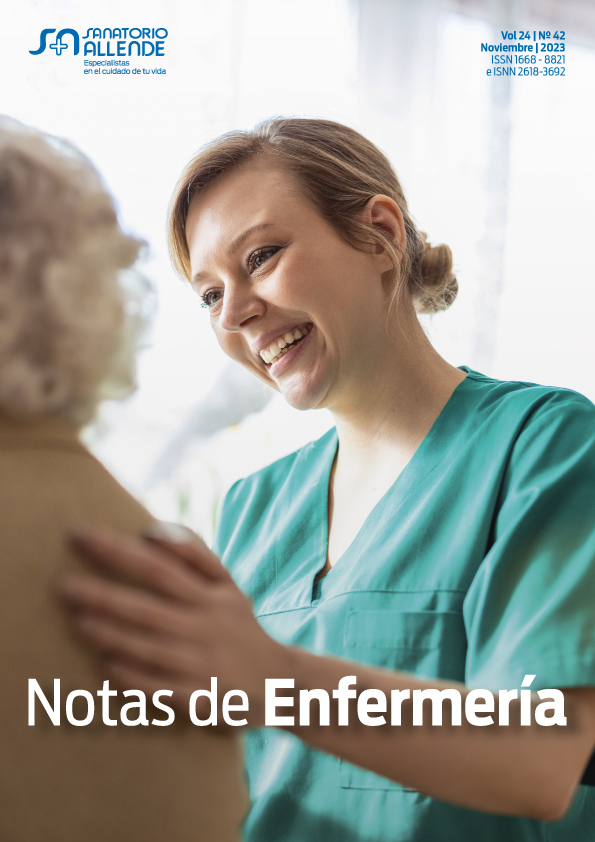Level of nursing knowledge about the management of the implantable catheter at the Pediatric Hospital, Chaco 2022
DOI:
https://doi.org/10.59843/2618-3692.v24.n42.42911Keywords:
Catheters, knowledge, nursing care, management, Patient Care ManagemenAbstract
Introduction: the implantable catheter in pediatric patients is one of the most used and important elements, used in treatments for extended periods. These devices are the responsibility of the nursing area in terms of their maintenance and care, with their control comfort and greater safety are provided to the patient. Objective: To determine the level of knowledge of the nursing professional on the management of the implantable catheter in hospitalization services of a Pediatric Hospital, Chaco, year 2022. Methodology: quantitative, descriptive, cross-sectional and observational study; study population the entire nursing staff of the hospitalization service; A written questionnaire was used as a data collection instrument, which contained the sociodemographic variables and knowledge of general aspects, knowledge in the habilitation and maintenance of the implantable catheter. Results: the results obtained in the investigation show a regular level of knowledge in general aspects of the implantable catheter, however, the level in the qualification. and maintenance of the implantable catheter according to the academic training achieved by the staff working in the hospitalization services, it was observed that nursing and specialist graduates obtained a higher percentage in good knowledge. Conclusion: it is concluded that there are general aspects about the management of the implantable catheter that require a reinforcement of knowledge by the nursing staff in pursuit of continuous improvement in care.
Downloads
References
(1) Instituto Nacional del Cáncer. Mejoró el pronóstico del cáncer infantil en nuestro país [Internet]. Argentina. gob.ar; 17 de febrero de 2019 [Consultado 20 de Abril de 2022] Disponible en: https://www.argentina.gob.ar/ noticias/mejoro-el-pronostico-del-cancer-infantil-en-nuestro-pais
(2) Rocco, C.; Garrido, A. Seguridad del Paciente y Cultura de Seguridad. [Rev. Med. Clin. Condes - 2017; 28(5) 785-795]. Disponible en: https://doi.org/10.1016/j.rmclc.2017.08.006
(3) Lamas M., Aparicio C. Implementación de Proyecto Educativo, folleto guía para padres: “Cuidados de catéter semi-implantable e implantable”. Una aproximación a la teoría de Kathryn E. Barnard. Notas enferm. [Internet]. 12 de julio de 2018 [citado 29 de abril de 2022];18 (31). Disponible en: https://revistas.unc.edu.ar/ index.php/notasenf/article/view/21661
(4) Felipe I., Álvaro E., Erick C., Eduardo C., Carlos F., Jorge L., et al. Accesos venosos centrales. Artículo de actualización Cuad. Cir. 2011; 25: 52-58.
(5) Schwartz, Ricardo. "Acceso venoso prolongado en el paciente oncológico." Rev. Med. Clín. Condes 17.2 (2006): 49-53. Disponible en: http://www.clc.cl/clcprod/media/contenidos/pdf/MED_17_3/ AccesoProlongadoPacienteOncologico.pdf
(6) Freiré E., Iglesia A., Rodríguez C., López M. A., González M., Peleteiro R. et al. Reservorios venosos centrales totalmente implantables, tipo Port-A-Cath, en pacientes oncológicos: Revisión de Complicaciones. Rev. Soc. Esp. Dolor [Internet]. 2008 Oct [citado 2022 Abr 30]; 15(7): 451-462. Disponible en: http://scielo. isciii.es/scielo.php?script=sci_arttext&pid=S1134-80462008000700004&lng=es
(7) Vázquez L.F., Jordán GJA. Colocación de reservorio subcutáneo venoso central permanente. Invest. Medicoquir. 2018;10(1):167-179. Disponible en: https://www.medigraphic.com/cgi-bin/new/resumen. cgi?IDARTICULO=85513
(8) Hospital Italiano de Buenos Aires. Comité de Control de Infecciones. Última revisión: diciembre 2015. Disponible en: https://www1.hospitalitaliano.org.ar/multimedia/archivos/noticias_archivos/74/ documentos/74_Cateteresguia.Diciembre2015Final.pdf
(9) Sanchez G, Oshe M, Euliarte C. Manual de normas de prevención de control de infecciones relacionadas al manejo de catéter implantable. Hospital Dr. Avellino Castelán. Edición Nª 3, enero 2009. Disponible en: https://es.slideshare.net/maur_jmp/manual-de-oncolo1-copy
(10) Baltazar E; Cedro M; Heredia LM. Conocimiento del personal de enfermería sobre el manejo y cuidado de catéter implantable en el servicio de unidad de terapia intensiva del hospital pediátrico Dr. Humberto Notti en el periodo de 2018. Escuela de Enfermería. Ciclo de Licenciatura en Enfermería. Taller de Tesis. Mendoza, diciembre 2018. Disponible en: https://bdigital.uncu.edu.ar/objetos_digitales/12088/baltazar-esther.pdf
(11) Ramírez M.; Bernárdez A.; Cáceres M.; Fretes G.; González A. Procesos de mejora sobre los conocimientos de los cuidados de enfermería en pacientes con catéter implantable de larga permanencia. 2018. Disponible en: http://repositorio.hospitalelcruce.org/xmlui/handle/123456789/800
(12) Bacilio P., Villalobos V. Nivel de conocimiento y cuidado que brinda la enfermera al paciente con catéter venoso central en unidades de cuidados críticos del hospital belén de Trujillo – Perú 2013. Disponible en: https:// hdl.handle.net/20.500.12759/235
(13) Baquero R. Guía de procedimientos asistenciales para la colocación y manejo del catéter venoso central en la seguridad del paciente en la UCIN del Hospital San Bartolomé. Lima- Perú 2018. Disponible en: https:// hdl.handle.net/20.500.12692/28280
(14) Tirado-Reyes R.J., Silva-Maytorena R. Nivel de conocimiento y cuidado enfermero del paciente con catéter central en Culiacán, Sinaloa, México. Rev. Enferm. Inst. Mex. Seguro Soc. 2020; 28(1):25-36. Disponible en: https://www.medigraphic.com/cgi-bin/new/resumen.cgi?IDARTICULO=94016
(15) Graciela Yusimi Barroso Gonzales, Zamora GZM de las M. Cuidados de enfermería en pacientes con reservorio (port-a cath) y su repercusión en la comunidad. Coloq. panam. investig en enferm. 2018. Disponible en:http://repositorio.umsa.bo/xmlui/handle/123456789/27113
Downloads
Published
Issue
Section
License
Copyright (c) 2023 Sanatorio Allende

This work is licensed under a Creative Commons Attribution-NonCommercial 4.0 International License.
Those authors who have published with this journal, accept the following terms:
- Attribution — You must give appropriate credit, provide a link to the license, and indicate if changes were made. You may do so in any reasonable manner, but not in any way that suggests the licensor endorses you or your use.
- NonCommercial — You may not use the material for commercial purposes.

